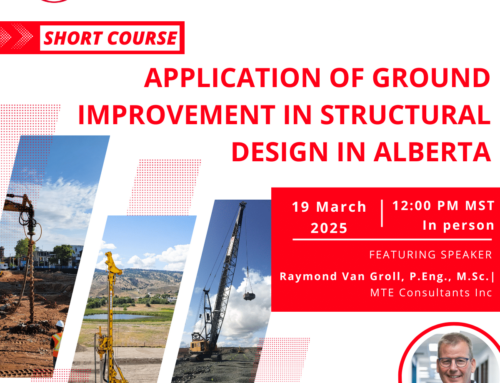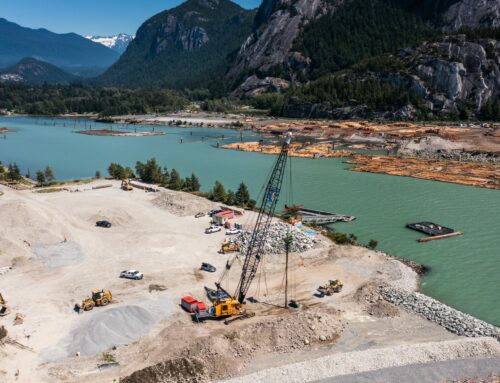
Digging Deeper: Exploring the Next Frontier in Soil Mechanics
MENARD CANADA GEOTECHNICAL SERIES
Soil mechanics, the study of soil behaviour under various conditions, has undergone an interesting evolution throughout history. From ancient civilizations’ basic understanding to the sophisticated methodologies of modern science, the journey of soil mechanics spans thousands of years.
Primarily based on a trial-and-error approach, early civilizations’ fundamental understandings of soil mechanics laid the foundation for what would later evolve into a systematic scientific study. In the Renaissance period (the 14th century), soil mechanics slowly began to materialize into what we know today as soil mechanics. Early thinkers like Leonardo da Vinci and Daniel Bernoulli made significant contributions to the field, exploring concepts such as soil stability and bearing capacity in their works. The period that followed witnessed a further evolution of soil mechanics as scientific investigation grew across Europe. Intellectuals and engineers began to apply practical mathematical principles to analyze soil behaviour, laying the groundwork for modern geotechnical engineering. Yet, it was not truly until the 19th century that soil mechanics really came into its own as a distinct discipline, with pioneers like Karl von Terzaghi leading the way.
Terzaghi often hailed as the father of modern soil mechanics revolutionized the field with his rigorous mathematical and experimental methods. His influential work on consolidation theory, shear strength, and effective stress principle laid the foundation for modern geotechnical engineering, ushering in a new era of scientific precision. As we moved through the 20th century, we witnessed unprecedented advancements in soil mechanics. This was mainly due to new laboratory testing techniques and instrumentation that were undergoing major innovations, enabling researchers to study soil properties with unparalleled precision, especially with the advent of computer modelling and numerical analysis; this transformed the way engineers predict soil behaviour.
Today, soil mechanics stands at the forefront of scientific investigation, continuing to evolve with advancements in technology and interdisciplinary collaboration. The integration of geospatial technologies, machine learning algorithms, and sustainable construction practices holds immense promise for addressing pressing global challenges in infrastructure development and environmental conservation. Soil mechanics currently stands on the edge of a transformative era. As we venture into the 21st century, advancements in both technology and sustainability are poised to reshape the landscape of soil mechanics. Below is a list of possibilities and challenges that lie ahead in the future of soil mechanics.
Integration of Advanced Technologies:
The future of soil mechanics will be intricately intertwined with cutting-edge technologies. Remote sensing technologies, like LiDAR and satellite imagery, will enable researchers to map soil properties with unprecedented accuracy and resolution over large spatial scales. Moreover, advances in sensor technology and Internet of Things (IoT) devices will facilitate real-time monitoring of soil conditions, providing invaluable data for predictive modelling and decision-making.
The ongoing development of true Artificial Intelligence (AI) and Machine Learning (ML):
Artificial intelligence, as well as machine learning advanced algorithms, are poised to revolutionize soil mechanics by unlocking new insights from vast amounts of data. These powerful tools can analyze complex datasets to identify patterns, optimize design parameters, and predict soil behaviour with greater accuracy. From optimizing soil stabilization techniques to assessing geohazards, AI and ML have the potential to change the way we approach geotechnical engineering challenges.
Advancements in Sustainable Practices:
With more concern about environmental sustainability, the future of soil mechanics will prioritize eco-friendly solutions and practices. Innovative soil stabilization techniques using bio-based materials, such as biopolymers and plant-derived additives, will gain prominence as alternatives to traditional chemical stabilizers. Additionally, holistic approaches that consider the ecological impact of soil management will become increasingly important in mitigating soil degradation and promoting ecosystem resilience.
Interdisciplinary Collaboration:
The future of soil mechanics will be characterized by interdisciplinary collaboration, bridging the gap between geotechnical engineering, environmental science, and other fields. Collaborative research endeavours will foster a more holistic understanding of soil-structure interactions, considering factors such as climate change, urbanization, and land use dynamics. By integrating diverse perspectives and expertise, we can develop innovative solutions to complex geotechnical challenges.
Challenges and Opportunities:
Despite the promise of advancements, the future of soil mechanics also presents significant challenges. Climate change, urbanization, and population growth are exerting unprecedented pressures on soil resources, leading to soil degradation, erosion, and land subsidence. Addressing these challenges will require innovative approaches, resilient infrastructure designs, and proactive soil management strategies. Furthermore, ensuring equitable access to soil resources and fostering sustainable land use practices will be essential for promoting social and environmental justice.
The future of soil mechanics holds great promise for addressing global challenges in infrastructure development and environmental conservation, and we have come a long way in understanding the complex behaviour of soil, but as we continue on this journey of discovery, let’s stay committed to preserving the integrity of our soils and nurturing the vital ecosystems they support.
Sources:
- ResearchGate
https://www.researchgate.net/publication/353697756_Historical_background_and_evolution_of_Soil_Mechanics - ScienceDirect
https://www.sciencedirect.com/topics/earth-and-planetary-sciences/soil-mechanics




